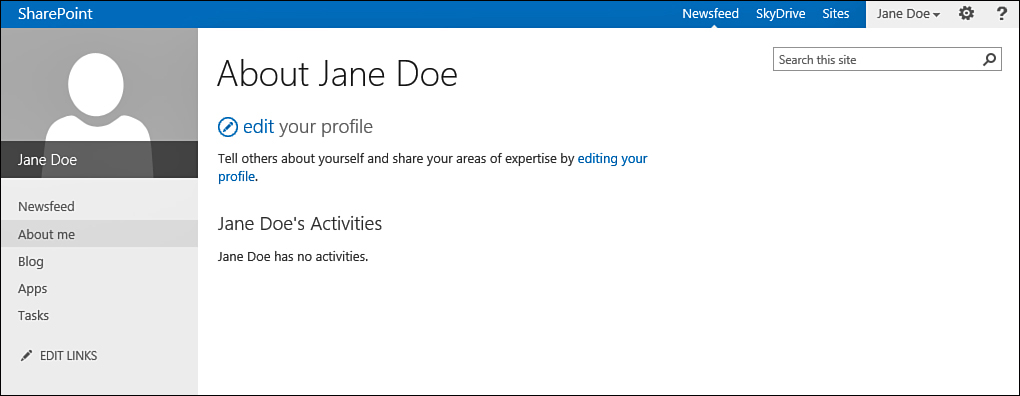1. What Is a Personal Site?
A personal site is one that belongs to a
specific user and is used to show user information that belongs,
personally, to that user. The user can upload documents to a personal
document library in the personal site, and only that user can see and
manage these documents. This document library is easily accessible to
the user using the SkyDrive link at the top of all SharePoint pages.
The personal site is also a place where users
can manage their personal favorite items and comments that they have
tagged throughout SharePoint or even outside SharePoint . The personal site has special pages with
information that might be important to track. A user can track
information by using newsfeeds that tell what colleagues are up to. In
addition, users can run searches and stay up to date on those subjects.
In addition, the personal site is usually the place from which users
can modify their personal details in the corporate directory. An
example of a basic personal site is shown in Figure 1.

FIGURE 1 A personal site, showing the owner’s information and links to the site’s content.
A personal site usually has components that
display information targeted specifically to that user. For example, it
might have components that show the user’s email, upcoming meetings
from the person’s calendar, a list of documents the user has recently
worked on, and tasks assigned to the user.
Note
As mentioned earlier, personal sites are available only with SharePoint Server and some SharePoint 365 plans, but not with SPF.
2. What Are SkyDrive and SkyDrive Pro?
With SharePoint 2013, Microsoft introduced a concept called SkyDrive
into the SharePoint product, in addition to the Microsoft SkyDrive
product that is available outside of SharePoint. As part of this
concept, a SkyDrive link might appear on SharePoint pages’ navigation,
and when clicked, the user is by default redirected to the document
library of the user’s personal site. This document library serves as
the user’s personal, corporate SkyDrive (instead of being hosted by
Microsoft, which is the original SkyDrive product). This library is
also known as SkyDrive Pro (the two terms can get mixed up, where in some pages they are referred to as SkyDrive, and in some SkyDrive Pro).
The two terms also refer to client
applications (installed on your computer)—one a free download from
Microsoft called SkyDrive that is meant to synchronize your computer
with your Microsoft SkyDrive (not SharePoint), and the other, SkyDrive
Pro 2013, which comes as part of Microsoft Office 2013 and allows you
to synchronize specific SharePoint document libraries and folders
between SharePoint and your computer. This way, you can save a document
to a specific folder on your computer, and it will be automatically
uploaded to a specific folder in SharePoint, and vice versa.
3. What Is a Ribbon?
As part of the Microsoft Office product family, SharePoint 2013 uses a design concept called a ribbon
to display different menus and buttons, depending on what you are
looking at. Knowing how to use the ribbon is important so you can move
around in a site and perform actions in it.
4. What Are Apps?
Apps are a new concept in SharePoint
2013. This all-encompassing term covers anything from site templates
(different types of sites), list templates (different types of
lists—for example, the Calendar list type is known as a Calendar app),
web parts , and custom solutions that developers can develop and deploy
to a site. You can purchase apps and install them in your site, or you
can just use the ones that came out of the box with SharePoint.
5. What Is a List?
A SharePoint list is a container for
information, similar to a simple database or spreadsheet. Using a list
is the most common way to manage information in a SharePoint site.
In a list, data is gathered in rows, and each row is known as a list item. A list can have multiple columns—also known as properties, fields, or metadata. So a list item is a row with data in those columns.
For example, a list of contacts (as shown in Figure 2) may have the following columns:
- First Name
- Last Name
- Company
- Phone

FIGURE 2 A contacts list, with sample data.
These columns may have the following list items:
- First Name: John
- Last Name: Doe
- Company: Extelligent Design
- Phone: 1800-000-000
Lists can be used in many
cases. For example, you might use lists for links, tasks, discussions,
announcements, or events. In SharePoint, users can create lists and
columns. Lists can be used for almost anything that can be described by
a group of columns.
The information in lists can be displayed on
pages in a SharePoint site. For example, if the site manager wants to
display a list of links on the site, that manager can add a web part .
Different lists can have different security
settings. List managers can define, for example, who is allowed to add
items to a list, who is allowed to edit items, who is allowed to read
the items, and so on. Similarly, each list item can have its own
security settings, so different list items can be visible to different
people. For example, an item that is a link to a restricted site can
have security settings that prevent users who don’t have access to that
site from seeing it.
In some lists, you can attach files to list
items—much like attachments in email. For example, in a contacts list,
you could attach to each contact a picture and a resume, or in a list
of tasks, you might attach documentation of what needs to be done to
the task.